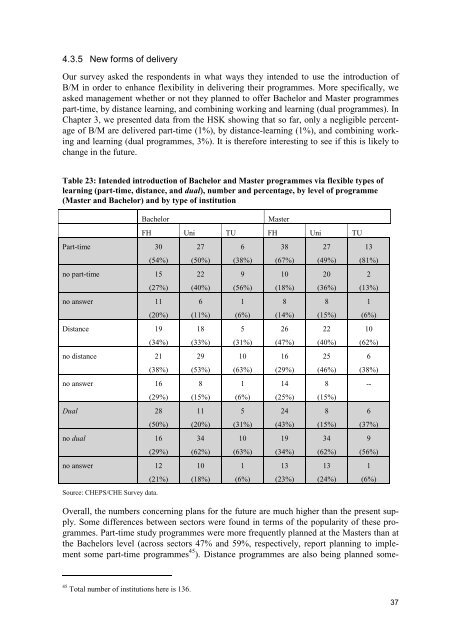and Master Programmes in German Higher Education Institutions
and Master Programmes in German Higher Education Institutions
and Master Programmes in German Higher Education Institutions
- No tags were found...
You also want an ePaper? Increase the reach of your titles
YUMPU automatically turns print PDFs into web optimized ePapers that Google loves.
4.3.5 New forms of deliveryOur survey asked the respondents <strong>in</strong> what ways they <strong>in</strong>tended to use the <strong>in</strong>troduction ofB/M <strong>in</strong> order to enhance flexibility <strong>in</strong> deliver<strong>in</strong>g their programmes. More specifically, weasked management whether or not they planned to offer Bachelor <strong>and</strong> <strong>Master</strong> programmespart-time, by distance learn<strong>in</strong>g, <strong>and</strong> comb<strong>in</strong><strong>in</strong>g work<strong>in</strong>g <strong>and</strong> learn<strong>in</strong>g (dual programmes). InChapter 3, we presented data from the HSK show<strong>in</strong>g that so far, only a negligible percentageof B/M are delivered part-time (1%), by distance-learn<strong>in</strong>g (1%), <strong>and</strong> comb<strong>in</strong><strong>in</strong>g work<strong>in</strong>g<strong>and</strong> learn<strong>in</strong>g (dual programmes, 3%). It is therefore <strong>in</strong>terest<strong>in</strong>g to see if this is likely tochange <strong>in</strong> the future.Table 23: Intended <strong>in</strong>troduction of Bachelor <strong>and</strong> <strong>Master</strong> programmes via flexible types oflearn<strong>in</strong>g (part-time, distance, <strong>and</strong> dual), number <strong>and</strong> percentage, by level of programme(<strong>Master</strong> <strong>and</strong> Bachelor) <strong>and</strong> by type of <strong>in</strong>stitutionBachelorPart-time 30<strong>Master</strong>FH Uni TU FH Uni TU(54%)no part-time 15(27%)no answer 11(20%)Distance 19(34%)no distance 21(38%)no answer 16(29%)Dual 28(50%)no dual 16(29%)no answer 12Source: CHEPS/CHE Survey data.(21%)27(50%)22(40%)6(11%)18(33%)29(53%)8(15%)11(20%)34(62%)10(18%)6(38%)9(56%)1(6%)5(31%)10(63%)1(6%)5(31%)10(63%)1(6%)38(67%)10(18%)8(14%)26(47%)16(29%)14(25%)24(43%)19(34%)13(23%)27(49%)20(36%)8(15%)22(40%)25(46%)8(15%)8(15%)34(62%)13(24%)13(81%)2(13%)1(6%)10(62%)6(38%)--6(37%)9(56%)Overall, the numbers concern<strong>in</strong>g plans for the future are much higher than the present supply.Some differences between sectors were found <strong>in</strong> terms of the popularity of these programmes.Part-time study programmes were more frequently planned at the <strong>Master</strong>s than atthe Bachelors level (across sectors 47% <strong>and</strong> 59%, respectively, report plann<strong>in</strong>g to implementsome part-time programmes 45 ). Distance programmes are also be<strong>in</strong>g planned some-1(6%)45 Total number of <strong>in</strong>stitutions here is 136.37
















